
Everglades National Park, Florida
The Everglades
The Everglades is a vast tropical wetlands area stretching from Orlando in the North to the Southern tip of mainland Florida. The National Park covers only the lower third of the area. We visited at the end of Florida’s ‘Winter’ which is the dry season when a lot of the wetlands dries up and consequently wildlife becomes highly concentrated in the remaining areas with water. This makes it one of the best places in the world to observe the animals and birds that make this their home. Unfortunately for us this year, the winter was extremely wet so the concentration of wildlife was much less than normal. Although there is certainly no shortage of water in Southern Florida there is a constant struggle to find a balance between the needs of farming, urban development and the preservation of this unique and diverse environment.
Most of the water feeding the area in the National Park flows South over vast sawgrass prairies during the wet season from urban and farming areas starting as far North as Orlando. Many previous attempts to manage the water resources have had damaging effects to the area covered by the Park but it seems that all parties involved are now more aware of each others needs and there is hope that the area will be preserved.
We entered the Park after driving through the intensive crop production area near Homestead and saw multitudes of migrant workers in the fields and were surprised by large areas of budget housing, some in gated communities, provided for them. The sunshine through the irrigation spray caused some great rainbow effects (see below). We split our stay between two campgrounds, Long Pine Key to the North and Flamingo to the South. 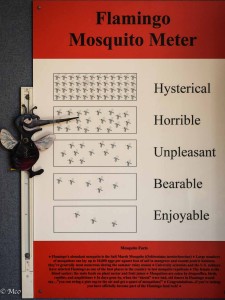 Our stay in Flamingo was cut short due to the early crop of mosquitos which had invaded as a consequence of the wet Winter and early Spring. Our new weapon against these obnoxious insects (a ‘Jolt’ portable bug zapper) was effective but the volume of insects during the dawn and dusk hours eventually persuaded us to move back North to Long Pine Key.
Our stay in Flamingo was cut short due to the early crop of mosquitos which had invaded as a consequence of the wet Winter and early Spring. Our new weapon against these obnoxious insects (a ‘Jolt’ portable bug zapper) was effective but the volume of insects during the dawn and dusk hours eventually persuaded us to move back North to Long Pine Key.
While in Flamingo we took two boat rides, one out into Florida Bay and the other inland. We also took advantage of the many boardwalk trails into the areas where water remains in the Winter and provides sustenance for animal and birdlife in addition to the Mangrove, Cypress, and Mahogany trees.
Click on any thumbnail below to see full-size images of irrigation ‘rainbows’
- Crop irrigation near Park Entrance
- Rainbow through spray
Long Pine Key
Long Pine Key campground is situated in a forest of beautiful tall pine trees by a small lake. Campsites are well separated and even though the facilities are sparse at present (restrooms being rebuilt, no power at sites), this didn’t bother us in our Roadtrek which is pretty self-contained. We saw and heard quite a bit of birdlife and enjoyed the quiet (at least during the week). Cheryl was happy to find that our antenna booster put us just in range of a cell connection that provided a workable Internet connection. It was a great location for easy access to Royal Palm trails, the Nike Missile Site and the Paheyokee Overlook trails (see below).
Royal Palms
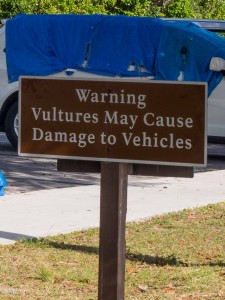 Royal Palms has a Visitor Center and has access to the Anhinga Trail boardwalk (the most beautiful in the Park in our opinion) and the Gumbo Limbo trail through dense jungle. The parking lot for Royal Palms had an unusual sign that we hadn’t seen before. It was the warning to visitors to use the provided blue tarps as covers on cars. Apparently, the vultures love to eat the rubber. Cheryl theorized it was the taste of high speed smashed bugs on the windshield wipers and they seem to like window seals also. We stayed away from the times of day when they invaded.
Royal Palms has a Visitor Center and has access to the Anhinga Trail boardwalk (the most beautiful in the Park in our opinion) and the Gumbo Limbo trail through dense jungle. The parking lot for Royal Palms had an unusual sign that we hadn’t seen before. It was the warning to visitors to use the provided blue tarps as covers on cars. Apparently, the vultures love to eat the rubber. Cheryl theorized it was the taste of high speed smashed bugs on the windshield wipers and they seem to like window seals also. We stayed away from the times of day when they invaded.
There was much to see from the Anhinga Boardwalk and Colin enjoyed the Gumbo Limbo trail, particularly the trees which are also named ‘Tourist Tree’ because of their red peeling bark. I particularly appreciated Cheryl’s sharp eyes spotting the Purple Gallinule which gave us such fun watching him use his big feet walk over the lillies.
Click on any thumbnail below to see full-size gallery
- Red-Shouldered Hawk
- Snowy Egret ‘Hat Feathers’
- Anhinga Wing Drying
- Bromeliad Air Plant
- Water Lilies in bloom
- Snowy Egret taking off
- Dragonfly
- Anhinga
- Anhinga
- Anhinga
- Purple Gallinule
- Big Foot
- Walks on Lillies
- Strong Legs
- Turtle Family
- Anhinga Trail Boardwalk
- Alligator
- Colin next to a Gumbo Limbo tree at the start of the Gumbo Limbo trail
- Warning at Royal Palms
- No kidding
- Waiting…
Nike Missile Site
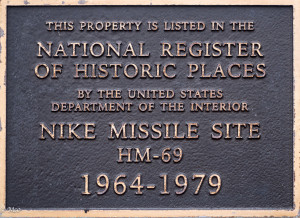 Hidden in the Park is the Nike Missile Site. This was built in response to the Cuban Missile crisis to add defensive capability against aircraft invasion from the South.
Hidden in the Park is the Nike Missile Site. This was built in response to the Cuban Missile crisis to add defensive capability against aircraft invasion from the South. 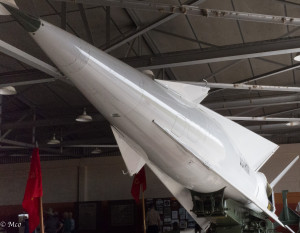 Nike-Ajax and Nike Hercules Missiles were assembled and deployed at three sites in the Park (Nike the Greek Winged Godess of Victory not the Sneaker manufacturer). The Park Service organizes daily tours and our volunteer guide did a great job of setting the scene for the deployment and giving a sense of what it was like to man these sites in those days.
Nike-Ajax and Nike Hercules Missiles were assembled and deployed at three sites in the Park (Nike the Greek Winged Godess of Victory not the Sneaker manufacturer). The Park Service organizes daily tours and our volunteer guide did a great job of setting the scene for the deployment and giving a sense of what it was like to man these sites in those days.
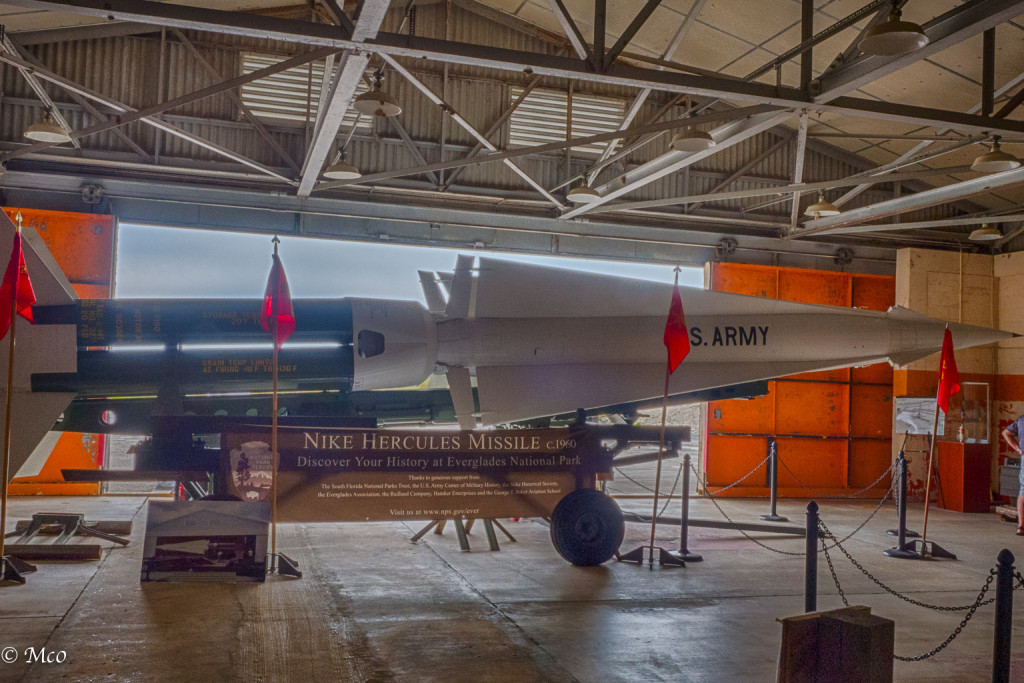
Payhayokee Overlook
We stopped here on our way to Flamingo and followed the boardwalk to a Mangrove Hammock where we found a Barred Owl surveying his territory. After we had moved on a few hundred yards we heard a great racket going on between a crow and the owl who had move into the depths of the thicket. Looking carefully into the trees we saw that in fact there was a pair of owls, presumably nesting with either eggs or chicks. This seemed to be the attraction for the crow. 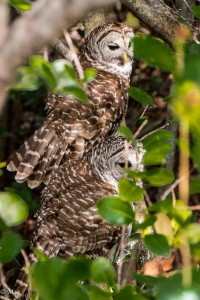 After a long argument, the owl finally took a run at the crow and chased him off. He then settled into the tree next to his mate and gave us a demonstration of the many faces an owl can make. It was very dark but I was able to capture some of his magnificent expressions.
After a long argument, the owl finally took a run at the crow and chased him off. He then settled into the tree next to his mate and gave us a demonstration of the many faces an owl can make. It was very dark but I was able to capture some of his magnificent expressions.
Click on any thumbnail below to see full-size gallery
- Defending eggs/chicks
- Sharp Talons
- Pair nesting
- Barred Owl on duty
Flamingo
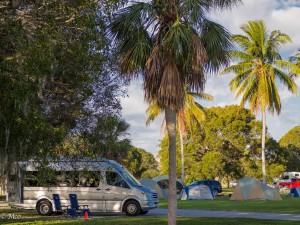 Flamingo is the end of the road from the Eastern Everglades NP. The only way on to Everglades City is by boat out to the Gulf or by canoe / kayak (week long journey). We decided against the trip and took two guided boat trips, one out into the Floriday Bay and the other through a canal to the internal waterways. Flamingo has a Visitor Center and Cafe, used to have a Motel which was destroyed by Hurricanes Katrina and Edna in 2005. The campground is on the shores of the Bay and our site was in an open area. We enjoyed relaxing in the warm breeze during the afternoons but had to retire inside the van at dusk to fight the mosquitoes that had somehow made their way in. We experienced some pretty sunsets while swatting the bugs.
Flamingo is the end of the road from the Eastern Everglades NP. The only way on to Everglades City is by boat out to the Gulf or by canoe / kayak (week long journey). We decided against the trip and took two guided boat trips, one out into the Floriday Bay and the other through a canal to the internal waterways. Flamingo has a Visitor Center and Cafe, used to have a Motel which was destroyed by Hurricanes Katrina and Edna in 2005. The campground is on the shores of the Bay and our site was in an open area. We enjoyed relaxing in the warm breeze during the afternoons but had to retire inside the van at dusk to fight the mosquitoes that had somehow made their way in. We experienced some pretty sunsets while swatting the bugs.
Click on any thumbnail below to see full-size gallery
- Sunset over Florida Bay
- Sunset over Florida Bay
- Sunset over Florida Bay
- Sunset over Flamingo Campground
- Sunset over Flamingo Campground
- Sunset over Flamingo Campground
- Campsite at Flamingo by Floriday Bay
- Florida Bay from the Flamingo Visitor Center
Inland fron Flamingo
 We took a two hour boat trip through the Buttonwood Canal to Coot Lake and on to Whitewater Lake where tidal salt waters from the Gulf mix with fresh water from the Everglades and were fortunate to find a Green Heron as well as a Great White and a Swallow-Tailed Kite in the distance. We came across some Manchineel trees which are poisonous to the touch and were used by native Indians to tip their arrows. (It was this poison on an arrow that finally killed the famous Spanish explorer Juan Ponce de Leon). We were hoping the kayakers we passed were well informed about dangers. We saw some crocodiles (tolerant to salt water unlike Alligators) and noticed the dark brown water caused by tannin from decomposing Mangrove leaves.
We took a two hour boat trip through the Buttonwood Canal to Coot Lake and on to Whitewater Lake where tidal salt waters from the Gulf mix with fresh water from the Everglades and were fortunate to find a Green Heron as well as a Great White and a Swallow-Tailed Kite in the distance. We came across some Manchineel trees which are poisonous to the touch and were used by native Indians to tip their arrows. (It was this poison on an arrow that finally killed the famous Spanish explorer Juan Ponce de Leon). We were hoping the kayakers we passed were well informed about dangers. We saw some crocodiles (tolerant to salt water unlike Alligators) and noticed the dark brown water caused by tannin from decomposing Mangrove leaves.
Click on any thumbnail below to see full-size gallery
- Sunrise at Eco Pond
- Great White Heron
- Looking at his refection
- Green Heron…
- …on Mangrove Roots
- Swallow-Tailed Kite
- Manchineel Tree (poisonous)
- Crocodile (not alligator)
Florida Bay
We took a one and a half hour boat trip on a powered pontoon boat out into the expanse of water stretching from Southern Mainland Florida to the Keys. Like parts of the Chesapeake Bay, although broad, the area is mainly shallow, many areas only 2 -3 feet deep. The tidal range is only about 1 – 2 feet and our tour guide claimed it was possible to walk from the mainland to Key West across the Bay. The birds take to the the sand spits exposed at low tide and gorge on shellfish. We saw many white pelicans, cormorants, and plovers gathering to partake of the Smorgasbord of seafood. We also found a familiar sight to Chesapeake Bay sailors, an Osprey nest with three chicks on top of a channel marker.
Click on any thumbnail below to see full-size gallery
- Sandbar Feeding Ground
- White Pelicans, Plovers …
- Cormorant hangout
- Osprey pair with chicks
- On lookout
- Florida Bay boat trip
Click on map below to see larger version
Flamingo Campground, Everglades National Park

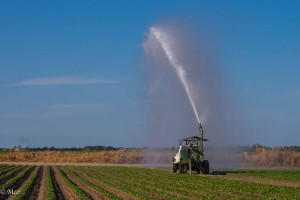
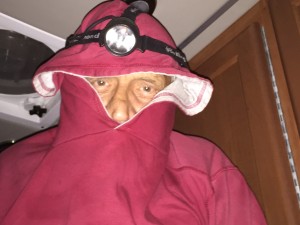
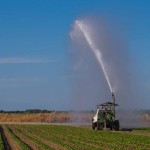
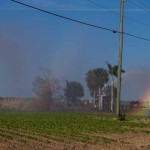
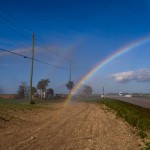
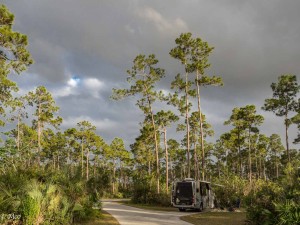
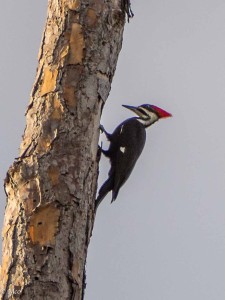
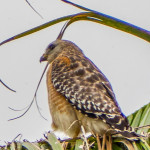
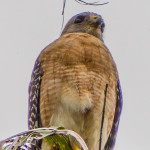
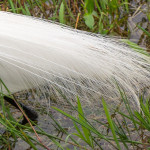
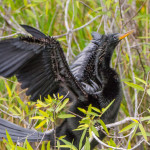
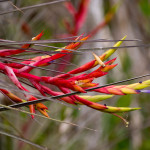
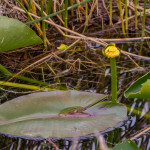
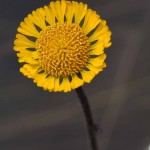
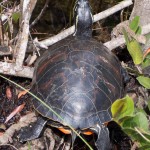
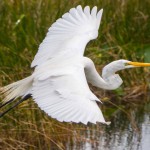
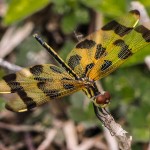
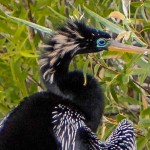
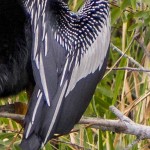
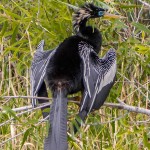
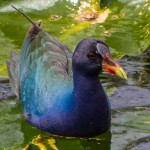
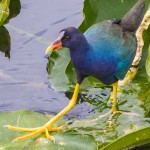
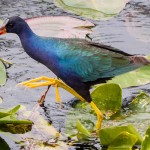
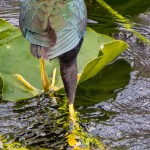
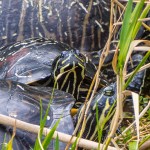
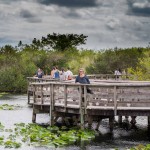
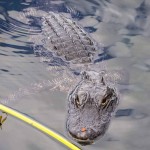
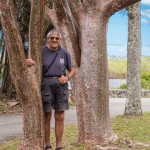
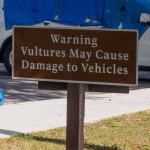
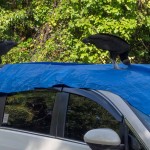
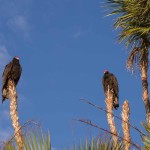
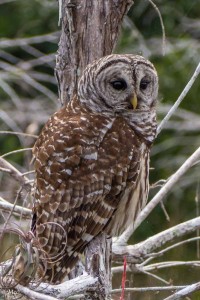
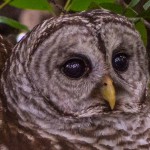
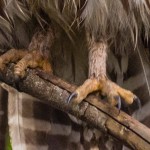
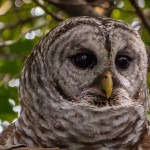
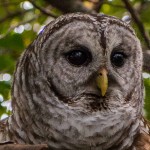
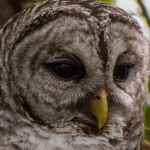
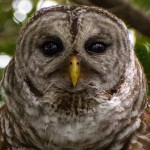
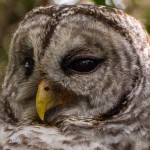
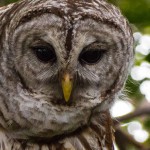
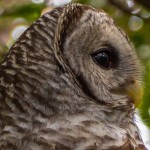
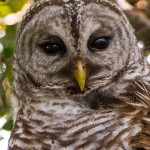
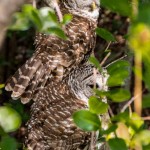
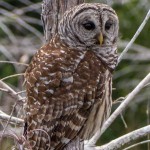
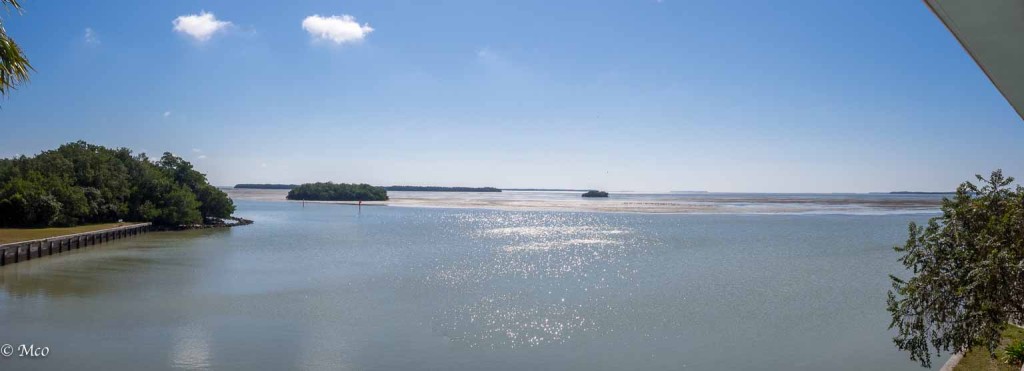
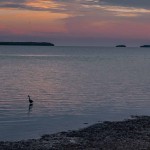
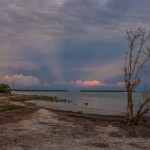
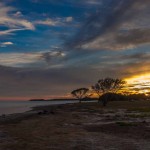
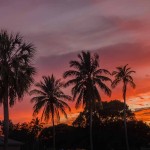
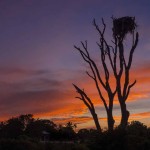
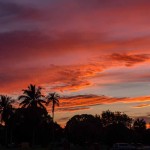
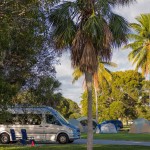
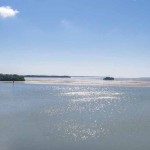
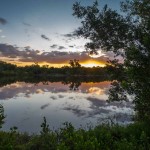
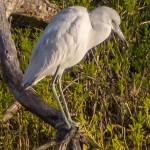
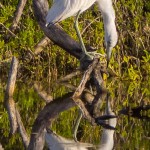
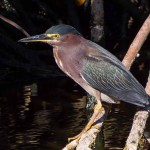
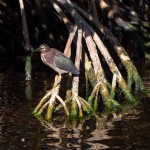
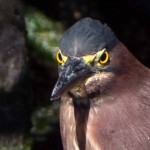
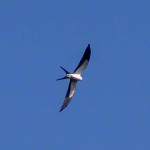
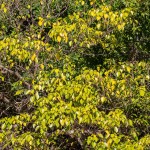
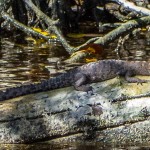
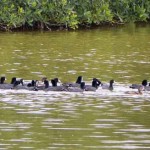
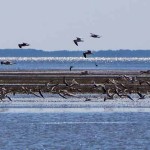
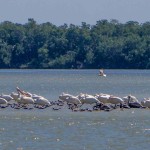
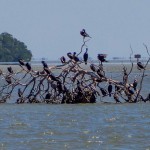
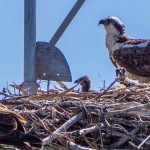
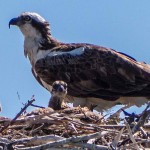
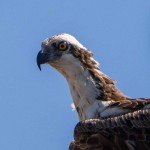
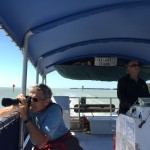
Very nice pictures of wild life in the Everglades national park. Watch at distance for the crocodiles and alligators. I am impress by the size of turtle shell! Keep shooting great pictures Colin. Have a nice trip around the USA. Hope you have plenty of sunscreen … Haha mosquitos loves burn skin and it is double pain.
Superbes photos qui font rêver!
Great pictures. Love the pensive owl. Hope you have stocked up on batteries for the Jolt..!
From Cheryl: Thank the heavens for the invention of Jolt, it has earned a very fond place in our hearts, killing those mosquitoes! Lots of batteries!
Love your pictures!!!
From Cheryl: Thanks Carol! It’s bringing us such fun entertainment!